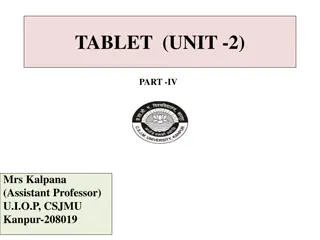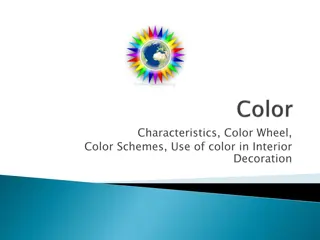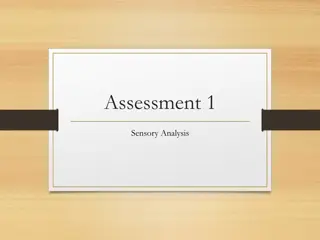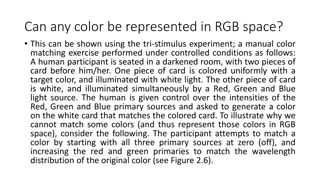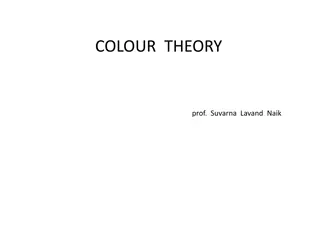Construction of an Achievement Test
Learn about achievement tests, standardized tests, oral tests, essay tests, and more for student evaluation. This guide discusses various types of tests and their purposes in assessing student learning. Enhance your understanding of educational assessment methods with this comprehensive resource
0 views • 29 slides
Understanding Bial's & Seliwanoff's Tests in Clinical Chemistry
Bial's and Seliwanoff's tests are chemical tests used to detect the presence of pentoses in a sample, distinguishing them from hexoses. These tests involve specific reactions with reagents to produce distinct color changes based on the type of sugar present. The Bial's test, particularly sensitive t
0 views • 17 slides
Fun Art Task: Creating a Color Wheel
Explore color relationships by mixing secondary and tertiary colors to create a vibrant color wheel. Learn about primary, secondary, and tertiary colors, and follow step-by-step instructions to create your own color wheel using basic art supplies. Enhance your understanding of color theory through t
1 views • 12 slides
Comprehensive Overview of Pulmonary Function Tests (PFTs)
Pulmonary Function Tests (PFTs) are vital for assessing pulmonary gas exchange through ventilation, diffusion, and lung perfusion. These tests include measurements of lung volume, airway patency, gas exchange efficacy, and pulmonary blood flow. PFTs offer benefits in diagnosing dyspnea, monitoring d
0 views • 14 slides
Understanding Verbal and Non-Verbal Tests
Verbal and non-verbal tests serve different purposes in assessing intelligence and skills. Non-verbal tests utilize images and diagrams to measure reasoning abilities without requiring reading or writing. Verbal tests, on the other hand, assess language-based skills through reading, writing, or oral
0 views • 14 slides
Understanding Renal Function Tests and Kidney Health
Renal function tests are essential for diagnosing and monitoring kidney health. These tests assess functions like glomerular filtration, tubular reabsorption, and endocrine functions of the kidneys. Common indicators include serum urea, creatinine levels, and more. It's crucial to evaluate renal fun
0 views • 34 slides
Color Tests for Proteins and Amino Acids
This experiment involves employing color tests to detect specific amino acids like tyrosine and tryptophan in proteins. Various reagents are used to observe distinctive color changes, indicating the presence of these amino acids. Detailed procedures, materials, and results are documented for each te
0 views • 19 slides
Understanding Different Types of T-Tests in Psychological Research
This article provides an overview of different types of t-tests used in psychological research, including independent t-tests for comparing two groups, paired or correlated t-tests for within-group comparisons, and the assumptions behind conducting these tests. It also includes examples of when to u
1 views • 7 slides
Understanding Non-Parametric Tests and Their Applications
Non-parametric tests serve as valuable alternatives to parametric tests when data do not meet specific criteria. This article explores the concept of non-parametric tests, types of non-parametric tests, and provides insights on conducting the Mann-Whitney U Test using SPSS for practical research app
4 views • 32 slides
Mastering Color in Film: A Comprehensive Guide to Using Color Grading Techniques
Explore the intricate world of color in filmmaking through understanding color grading, log explained, Log rec.709, color correction, and grading techniques without LUTs. Enhance your storytelling by harnessing the power of color to evoke emotions and create visual impact in your films.
1 views • 6 slides
Quality Control Tests for Tablet Production
Quality control tests play a crucial role in ensuring the safety and efficacy of tablet products. This article discusses various parameters like general appearance, size, shape, unique identification markings, organoleptic properties, hardness, friability, weight variation, and content uniformity th
1 views • 11 slides
Understanding Types of Test and Evaluation in Education
Explore the various types of tests used in education, including pre-tests, mastery tests, and diagnostic tests. Learn about different mediums for testing, such as oral, written, and performance tests. Discover the role of examinees in essay-type and objective-type tests. Lastly, delve into different
1 views • 13 slides
Understanding Achievement and Aptitude Tests in Education
Explore the differences between achievement and aptitude tests, such as how they measure abilities and knowledge. Learn about teacher-made tests, standardized tests, low-stake, and high-stake tests. Discover the importance of achievement tests in evaluating present proficiency and aptitude tests in
1 views • 16 slides
Gonorrhea Diagnostic Methods and Tests Overview
Dr. Mohammad Ahmad El Khayyat, an Assistant Professor in Dermatology, STDs, and Andrology, details the diagnostic methods and tests for gonorrhea. Various tests including Gram stain, culture, antigen detection tests, and nucleic acid amplification tests are discussed, highlighting sensitivity and sp
1 views • 30 slides
Carbohydrate Color Tests Experiment Summary
This experiment explores color tests for carbohydrates, specifically the Molisch and Anthrone tests. The Molisch test is a general test for carbohydrates using concentrated sulfuric acid, while the Anthrone test involves the formation of a blue-green complex with carbohydrates. The presence of a pur
0 views • 13 slides
Understanding Achievement Tests in Education
Achievement tests play a crucial role in assessing student progress in schools, aiding curriculum planning, and evaluating teaching programs. These tests measure individual accomplishments after a period of learning, helping to determine the effectiveness of instruction. Characteristics such as reli
2 views • 30 slides
Integrated Language Tests and Assessments Overview
This content delves into integrated language tests and assessments, exploring the differences between separate skills tests and integrated tests. It covers the rationale behind integrating language skills, examples of integrated skills tests, as well as shortcomings to avoid in test design. Key aspe
2 views • 35 slides
Quality Control Tests for Pharmaceutical Packaging Materials
This article discusses quality control tests for pharmaceutical packaging materials focusing on glass containers. The tests include chemical resistant tests such as powdered glass test and water attack test, as well as hydrolytic resistance tests. Detailed procedures for each test are outlined along
3 views • 18 slides
Identification of Cardioactive Glycosides Through Chemical Tests
The laboratory experiments focus on identifying cardioactive glycosides through chemical tests like Baljets Test and Keller-Killians Test. These tests involve reactions with specific reagents to observe color changes and layer formations, helping in the identification of different parts of the glyco
2 views • 11 slides
Understanding Fauvism: Working with Colors and Color Schemes
Fauvism is an art movement known for its bold and arbitrary use of colors. Fauvist painters carefully selected colors to convey specific moods in their artworks. This guide explores Fauvism, color theory, and different color schemes to help you create your own expressive painting. Learn about comple
0 views • 8 slides
Understanding Color Theory: A Comprehensive Guide
Practical guidance on color theory including the color wheel, color schemes, and color psychology. Learn about the importance of utilizing various color schemes like monochromatic, complementary, and analogous to create effective designs. Understand how different colors convey meanings and emotions
0 views • 11 slides
Understanding Color: Characteristics, Color Wheel, and Interior Decoration
Color is a vital aspect of our everyday lives, evoking various emotions and perceptions. This article delves into the characteristics of color, the color wheel, color schemes, and the use of color in interior decoration. It explains how colors are perceived, the qualities of color like hue, value, a
1 views • 51 slides
Fun and Educational Color Mixing Experiment for Elementary Students
Engage elementary school students in a hands-on color mixing experiment using primary colors to create secondary colors. The activity involves visual demonstrations, color paddles, and mixing colored goo in bags to understand color blending and create unique color combinations. Through this interact
0 views • 7 slides
Qualitative Tests of Proteins & Amino Acids: Overview and Analysis
In this lab, you will delve into the qualitative tests for proteins and amino acids, understanding their structures, classifications, and importance in food and human nutrition. The tests include solubility tests and identification tests for both amino acids and proteins, revealing their presence an
0 views • 13 slides
Qualitative Tests of Proteins & Amino Acids - Lab Analysis Overview
This lab analysis covers qualitative tests for proteins and amino acids, including solubility tests and identification tests for amino acids and proteins. Specific tests like Ninhydrin test for -L amino acids, Xanthoproteic test for aromatic amino acids, and lead sulfite test for sulfhydryl group de
0 views • 13 slides
Understanding Attributes and Color Schemes in Graphics
Graphics systems utilize attributes to define how primitives are displayed, such as color and size, while color and grayscale can be stored in different ways like direct storage and indexed storage schemes. The RGB color components play a key role in determining the color shades, with various color
0 views • 51 slides
Sensory Analysis Tests in Food Evaluation
Explore different sensory analysis tests used in food evaluation, including paired comparison tests for sweetness, quantitative descriptive analysis for taste attributes, and affective tests like hedonic tests. Understand the purpose and methodology of each test to enhance product development and qu
0 views • 12 slides
Understanding Color: A Comprehensive Overview
Color is a fascinating aspect of our visual world, explored through the prism of science and light. This chapter delves into the origins of color perception, from Isaac Newton's study of the color spectrum to the reflection and transmission of light that determines how we see colors. Gain insights i
0 views • 28 slides
Understanding Color Blindness: Causes, Symptoms, and Types
Color blindness, also known as color vision deficiency, is a genetic disorder that affects the ability to distinguish between certain colors. It is caused by the absence of color-sensitive pigment in cone cells of the retina, often passed down on the X chromosome. Symptoms vary from difficulty diffe
1 views • 16 slides
The Impact of Colors on Decision Making in Visual Displays
Investigating the influence of color on decision-making, particularly in legal contexts, through the manipulation of photographs with different color schemes. Prior research suggests that color can play a crucial role in how visuals are perceived and remembered, especially in litigation settings. By
0 views • 37 slides
Exploring the Basics of Color Theory
Understand the essence of color with insights into the sources, perception, and interpretation of color. Dive into the color wheel, primary, secondary, tertiary, warm, cool, and neutral colors, and learn about color harmony to create visually pleasing designs.
0 views • 14 slides
Understanding Color Representation: RGB vs. CIE vs. HSV Models
Exploring the limitations of representing all colors in RGB space and the alternative approaches offered by the CIE color space and HSV color model. While RGB is limited by additive primaries, CIE provides a broader range of color representation, and HSV simplifies color perception by emphasizing hu
0 views • 8 slides
Understanding Color Blindness: Types, History, and Impacts
Color blindness, also known as color vision deficiency, affects individuals by limiting their ability to perceive certain colors. It was first discovered by John Dalton, who suffered from red/green color blindness himself. The two main types are red/green and blue/yellow color blindness, each with i
0 views • 19 slides
Understanding Color Blindness: Causes, Symptoms, and Diagnosis
Color blindness, also known as color vision deficiency, is a genetic disorder that affects the ability to distinguish between colors. John Dalton discovered color blindness in 1794. It is inherited in an X-linked recessive pattern and can cause difficulties in daily life, such as trouble seeing colo
0 views • 13 slides
Understanding Design Principles: Contrast, Repetition, Alignment, Proximity, Color Theory
Explore the significance of design principles such as contrast, repetition, alignment, proximity, and color theory in creating visually appealing and effective designs. Learn how contrast plays a vital role in guiding the viewer's attention and enhancing visual interest through various techniques li
0 views • 30 slides
DArT-2 Tests and Experiments Overview
The DArT-2 tests involve twin experiments - DArT-2 and DArT-Test, focusing on ensuring the performance of DArT-2 in studying underground argon. Various tests like electronic tests of the PDM and vacuum tests are conducted to guarantee proper operation. Challenges with vacuum sealing and solutions li
0 views • 8 slides
Understanding the Differences Between Objective and Projective Tests
Objective tests aim to maximize objectivity by providing structured response options, while projective tests delve into hidden emotions and conflicts through ambiguous stimuli. Pros of objective tests include standardization and reliability, but projective tests offer unique insights based on indivi
0 views • 10 slides
Understanding Unit Testing in Software Engineering
Concept Software is a discipline comprising various code pieces. Testing these codes together is complex but vital in Software Engineering. The process includes early testing like unit tests, pairwise/multiple component testing, module testing, integration testing, user tests, alpha tests, beta test
1 views • 6 slides
Exploring the Impact of Color in Film Studies
Delve into the fascinating world of color in films through a series of engaging activities and discussions. From black and white classics to vibrant modern movies, uncover how color choices influence storytelling, evoke emotions, and captivate audiences. Explore the history, science, and psychology
0 views • 6 slides
Understanding Color Theory: Basics and Applications
Color theory encompasses the color wheel, color harmony, and how colors are used. It provides a logical structure for organizing and creating colors. Primary, secondary, and tertiary colors play key roles in this theory, along with concepts like color harmony and context. By understanding color theo
0 views • 28 slides










